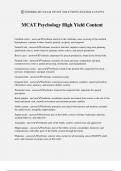©THEBRIGHT EXAM STUDY SOLUTIONS 8/22/2024 12:54 PM
MCAT Psychology High Yield Content
Cerebral cortex - answer✔✔Forebrain, known as the cerebrum; outer covering of the cerebral
hemispheres; contains 4 lobes: frontal, parietal, occipital, and temporal
Frontal Lobe - answer✔✔Forebrain; executive function, impulse control, long-term planning
(prefrontal cortex), motor function (primary motor cortex), and speech production
Broca's area - answer✔✔Forebrain; important for speech production, found in the frontal lobe
Parietal Lobe - answer✔✔Forebrain; sensation of touch, pressure, temperature and pain
(somatosensory cortex); spatial processing, orientation, and manipulation
somatosensory cortex - answer✔✔Forebrain; found in the parietal lobe, important for touch,
pressure, temperature, and pain sensation
Occipital lobe - answer✔✔Forebrain; visual processing
temporal lobe - answer✔✔Forebrain; sound processing (auditory complex), speech perception
(Wernicke's area), memory, and emotion (limbic system)
Wernicke's area - answer✔✔Forebrain; found in the temporal lobe; important for speech
perception
Basal ganglia - answer✔✔Forebrain; coordinates muscle movement from cortex to the rest of the
brain and spinal cord; smooth movements and maintain posture stability
limbic system - answer✔✔Forebrain; primarily associated with emotion and memory; includes
the septal nuclei, amygdala, hippocampus
Septal nuclei - answer✔✔Forebrain; part of the limbic system; feelings of pleasure, pleasure-
seeking behavior, and addiction
Amygdala - answer✔✔Forebrain; part of the limbic system, controls fear and aggression
Hippocampus - answer✔✔Forebrain; part of the limbic system; consolidates memories and
communicates with other parts of the limbic system through the fornix
Thalamus - answer✔✔Forebrain; sensory relay station for all incoming senses EXCEPT smell;
sorts, and transmits to proper areas of the cortex
, ©THEBRIGHT EXAM STUDY SOLUTIONS 8/22/2024 12:54 PM
Hypothalamus - answer✔✔Forebrain; active during high-arousal, aggressive behavior, and
sexual behavior; controls endocrine functions and ANS; maintains homeostasis
hypophyseal portal system - answer✔✔connects hypothalamus to anterior pituitary; maintains
coordination of the endocrine system
Hindbrain - answer✔✔"brain stem"; contains the cerebellum, medulla oblongata, and reticular
formation
Cerebellum - answer✔✔part of the hindbrain; controls motor movement, and balance
medulla oblongata - answer✔✔part of the hindbrain; controls breathing, reflex control, and
maintains upright posture
reticular formation - answer✔✔part of the hindbrain; controls normal behavior of walking,
sleeping, waking, and other reflexes; degenerative part of this section is related to Parkinson's
Disease
Midbrain - answer✔✔contains the inferior and superior colliculli
inferior colliculli - answer✔✔important midbrain nucleus that is involved in the auditory
pathway
superior colliculli - answer✔✔important midbrain nucleus that is involved in the visual pathway,
receiving information from the eye
Function of midbrain - answer✔✔reception of sensory and motor information; generally
necessary for survival
Forebrain - answer✔✔contains the thalamus, hypothalamus, basal ganglia, limbic system, and
cerebral cortex
Function of hindbrain - answer✔✔controls balance, motor coordination, breathing, and general
arousal (waking and sleeping); generally necessary for survival
Corpus Callosum - answer✔✔bundle of axons that connects the right and left hemispheres
Optic Chiasm - answer✔✔point in visual nerve system where nasal fibers (carrying temporal
vision) cross and the temporal fibers (carrying nasal vision) pass directly though to the optic tract
Bitemporal Hemianopsia: Lesion of Optic Chaism would cause would knock out the _____
fibers and the person would lose the ______ vision - answer✔✔Nasal fibers
Temporal vision
Nasal fibers - answer✔✔carry information from the temporal field of vision (Remember: visual
image crosses over and hits opposite side of retina)




